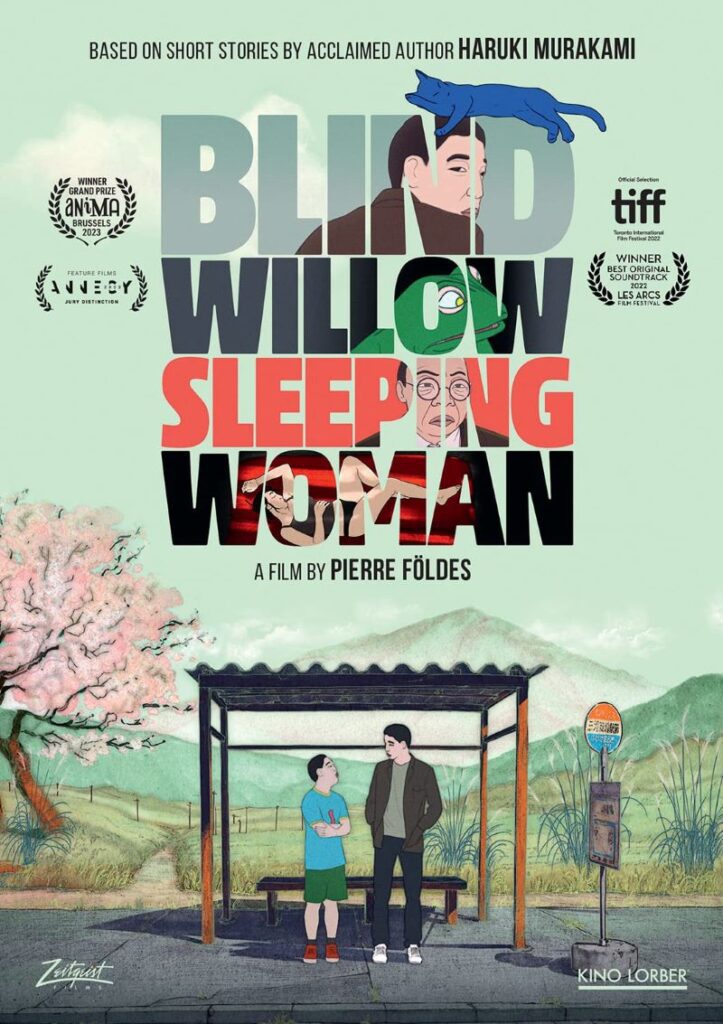
Writer/director/composer Pierre Földes stitches together unrelated Haruki Murakami short stories into a somewhat cohesive narrative in this animated feature film. The story is based in Japan shortly after their 2011 earthquake, and follows a few individuals as they try to get on with their daily lives. That drive for a return to normalcy proves to be problematic as they each encounter new challenges.
A young man named Komura is nursing serious depression after being left by his wife. Seeking a change, he leaps at the offer made by a co-worker to deliver a box of unknown contents to two young women. His wife, Kyoko, encounters a mysterious old man who claims he will grant her any wish she desires. Komura’s mousey, middle-aged colleague named Katagiri also receives an odd offer, being approached by a 7-foot-tall frog begging for his assistance to battle a fearsome giant worm threatening to demolish Tokyo by tsunami. Along the way, they encounter other characters who relate whimsical tales, establishing that wonderful things are happening all around their mundane world.
First-time writer/director Földes does a phenomenal job of combining six short stories from three different story collections by acclaimed novelist Haruki Murakami (Drive My Car) into one seemingly unified story. He accomplishes this by establishing previously nonexistent relationships between the stars of the individual stories, primarily via shared post-earthquake trauma and joint employment by Komura and Katagiri at the same bank. This grounds the characters in the same base location, even as they venture out on their own fantastic adventures. Although Földes utilizes numerical chapter breaks to signify changes in plot direction, the overall effect is one of unity, not disparate character voices.
Földes and his animation team utilize live-action 3D motion capture videos of the voice actors, but it’s clear that the captures were used more as reference than the final destination. As opposed to prior mocap films like Ralph Bakshi’s oeuvre or Richard Linklater’s forays into feature animation, this film still looks like native animation, not like painting laid over live action. That may be partially due to a rather low frame rate and limited camera movements, but the style works very well to keep the film looking like a cartoon, albeit an innovative one.
While the story primarily occurs in the real world with human characters, Földes makes his case for animation with occasional dips into the surreal. The segment featuring the giant talking frog is the biggest beneficiary of the format, but Földes also applies a rule to the entire film that only works in animation: all background characters are rendered slightly transparent. This technique naturally forces viewers to focus on the principal characters, but also gives their interactions an ethereal feel, as if they’re operating outside the humdrum existence experienced by their surrounding countrymen. It’s a simple concept, but it makes a huge impact on the effectiveness of the animation.
Even for a U.S. DVD release, it’s initially disconcerting that the default language is English for a French feature based in Japan. There is no Japanese audio option for the entirely Japanese characters, so the “native” language track is likely the alternate French option, although even that gets a bit murky due to the film’s unique co-production status between France, Canada, Luxembourg, and Netherlands. Regardless, the default English vocal cast does a fantastic job, especially Ryan Bommarito with his laid-back delivery of slacker Komura’s lines.
The DVD includes a few brief behind-the-scenes featurettes and a theatrical trailer. Audio options are 5.1 Dolby Digital Plus surround and 2.0 stereo. While it’s disappointing that the DVD format is the only physical media option offered, the animation style likely wouldn’t benefit from higher fidelity disc options. That’s due to an odd haze to the animation, as well as a subdued color palette. It’s as if the animators were working in pencil and intentionally smudging it over the finished frames, highlighting the handcrafted nature of the project. It adds a certain amount of charm to the finished product, but also dampens any need for 4K HDR.
Shockingly, Földes is primarily a composer, with no prior writing/directing credits or seemingly any experience with animation. He keeps his day job by also serving as the film’s composer, with his music contributions adding a warm, evocative touch. He has proven here to be far too talented to limit himself to music, hopefully marking this as a turning point in his career that will lead to more feature films in the future.